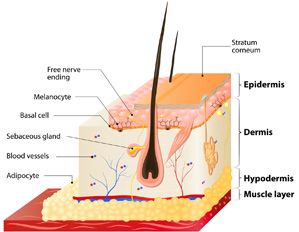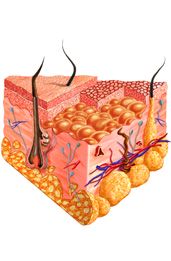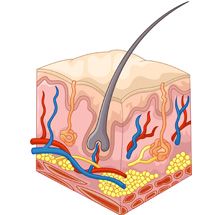The skin is a very large, extensive and extremely important organ. In humans, it is 15% of body weight, in the animals up to 24% (12-24%). Performs a number of important functions including protection, regulatory and secretory functions. Constitutes a barrier separating both the body from the environment, and it communicates with it.
- It is a mechanical protective barrier against environmental factors, physical stimuli, chemical and biological.
- Regulates the balance of water and electrolyte.
- Adjusts the internal temperature of the body, among others, ensured by features of the vascular bed and hair coat.
- Receives sensory stimuli, has touch receptors, temperature, pain and itching receptors.
- Has secretory function – sebaceous glands, sweat and perfumes.
- Participates in the synthesis of vitamin D.
- Produces keratin structure, i.e. hairs / fur and nails / claws.
- Performs the function of mechanical and chemical barrier against microorganisms, bacteria and fungi.
- Performs immune function, providing local immunity (Langerhans cells – dendritic cells presenting the antigen).
- Contains dye cells (melanocytes) – determines the color of skin and hair.
Skin is composed of three basic layers – from the outside:
Epidermis – five layers of epidermis (from the outside: cornified layer, clear/translucent layer, granular layer, spinous layer, basal/germinal layer).
Dermis
Hypoderm – subcutaneous tissue.
Each of these layers has a fixed functionality, although some of them contained in them structures (e.g. the sweat glands, hair follicles or sebaceous) penetrates the layers. The skin of the ears, lips, eyelids or the pads differs from the structure of the skin covering other parts of the body, eg. Merkel cells are located only in the skin of tips of paws.
The epidermis undergoes constant manufacturing processes and exfoliates any dead cells. Performs a number of important functions, ensures the continuity and integrity of the skin, produces keratin structures, i.e. hairs / fur and nails / claws. In the epidermis are located, among others, pigmentary cells (melanocytes), dendritic cells (Langerhans cells – immune processes) receptors of pressure and pain (Merkel cells) and openings of sebaceous glands, sweat glands, hair follicles and odoriferous glands. The epidermis is covered with a coat of fat and lipid (epidermal emulsion), which is responsible, among others, for the maintenance of an adequate level of acid-base balance of the skin (pH). This layer is also responsible for the hydration of the skin.
Dermis. In this layer, there is a series of functionally specific structures: the sebaceous glands, the sweat glands, scent glands, hair follicles and blood vessels, lymphatic vessels and nerves penetrating the layers of the epidermis and the so-called arrector pili muscle, responsible for “ruffling” of fur. In the dermis are embedded hair and nails. In this layer of the skin are cells of the immune system: macrophages, dendritic cells, basophils, and other cells like fibroblasts affecting, inter alia, proliferation of cells of the stratum corneum or mast cells involved in allergic reactions.
Subcutaneous tissue acts as a support, protects the body against low temperatures and a reserve of energy (mainly fats). It is composed of loose connective tissue (collagen fibers forming a loose network) and adipose tissue (fat droplets filled with the network of collagen fibers).
pH of the skin is acid-base equilibrium (or acidity) at the surface of the stratum corneum which is outermost skin layer. The acidity of the skin is regulated, among others, secretion of skin glands mostly sweat glands. In dogs, sweat secreted by the sweat glands do not participate in the process of thermoregulation as it has a place for humans. Suitable pH of the skin determines the skin’s resistance to bacterial infections, and is a prerequisite for maintaining homeostasis (equilibrium physiological). pH of the skin of dogs and cats is significantly different from the pH of human skin, as it is markedly higher, i.e. more alkaline. While the average pH of the surface of human skin is 5.2 – 5.6, canine pH of the skin ranges from 6.65 to 7.70. The alkaline nature of the animal skin gives much better than in the case of human skin, conditions for pathogenic microorganisms, bacteria and fungi. This is a frequent cause of complications in the form of bacterial and / or fungal infections in the course of some dermatoses. Similarly caused wounds (cuts, bites, etc.) are more susceptible to opportunistic infections complicating them and for this reason, among others, it is necessary to implement special procedures for dealing with wounds.
Coat hair (fur) has the essential protective functions acting as an insulating barrier and has thermoregulatory function as well as participates in the receiving environmental stimuli (receptor function) as well as in sending messages and information to the other animals (behavioral function).
The coat consists of several types of hair. Their occurrence, distribution, length and density varies between breeds of dogs and cats.
In the cover the hair are long, rigid, centrally located, single basic hair surrounded by several shorter basic hairs forming a covering, which are surrounded by dozens of smaller and more delicate and soft hairs forming the so-called undercoat. For some breeds of dogs (German shepherd) basic hair are surrounded by a very large amount of secondary hair, forming dense undercoat, in other breeds (Terriers) short and rough hair prevail, while in boxer’s basic hair are considerably shortened, and the amount of secondary, soft hair is clearly increased what gives the hair of dogs of these breeds specific “soft” character.
The color of the hair depends on the presence of pigmented cells located in the cortex of the hair.
The structure of the unit of coat is hair follicle, which includes a centrally located primary hair, a few (5) surrounding it shorter hairs and a few to a dozen secondary, soft hair. Each hair follicle is supplemented by the sebaceous gland and sweat and arrector pili muscle for tensioning the hair, which is responsible for “ruffling” of hair which has a thermoregulatory and behavioral functions. In dogs, the original hair has its own sebaceous and sweat glands, and arrector pili muscle for tensioning hair. The bellows create clustered follicles (follicle tufts).




